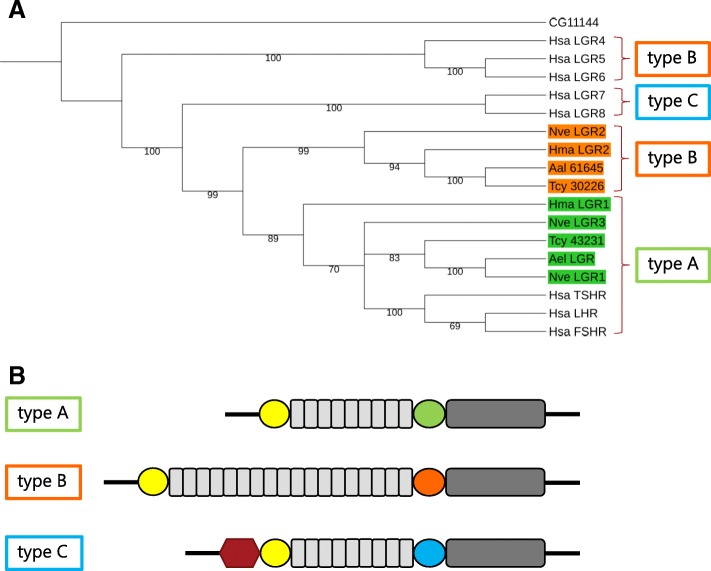Fig. 8.
Upper panel: A phylogenetic tree analysis of the Leu-rich repeats containing G Protein-coupled receptors (LGRs) from T. cystophora, and A. alata, together with some selected LGRs from other cnidarians and humans. The tree is routed with the Drosophila mGlu receptor CG2114. Lower panel: A cartoon (modified from [70]), showing the characteristic features of the A-, B-, and C-type LGRs. In this cartoon the transmembrane region is highlighted in dark grey and the extracellular leucine-rich repeats in light grey (LGR types -A, -B and -C have a characteristic number of these repeats drawn as boxes). The yellow circles are cysteine-rich domains preceding the leucine-rich repeats. Type-C has a low-density lipoprotein domain (drawn as a hexagon) preceding these yellow-marked cysteine-rich domains. In between the leucine-rich repeats and the transmembrane regions are cysteine-rich domains that are specific for either the A-, B-, or C-type (given as green, orange, and blue circles) LGRs. According to these features, the T. cystophora Tcy-43231-LGR (the number refers to Additional file 9, “LGRs”) is an A-type LGR (highlighted in green), which clusters together with the A-type LGRs from the sea anemone Anthopleura elegantissima (Ael-LGR; [53]), Hydra magnipapillata (Hma_LGR1), and Nematostella vectensis (Nve-LGR1 and Nve-LGR3). The other T. cystophora LGR (Tcy-30226-LGR, see Additional file 9) is a B-type LGR (highlighted in orange) and clusters together with the B-type LGRs from A. alatina (Aal-61645-LGR, see Additional file 9), N. vectensis (Nve-LGR2), and H. magnipapilla (Hma-LGR2). Other abbreviations are: Hsa, H. sapiens; FSHR, follicle-stimulating-hormone receptor; LHR, luteinizing hormone receptor; TSHR, thyroid-stimulating-hormone receptor. Additional file 9 gives the GenBank Data Bank accession numbers for the cubomedusan LGRs. The accession numbers for the other LGR sequences are given in the Methods

